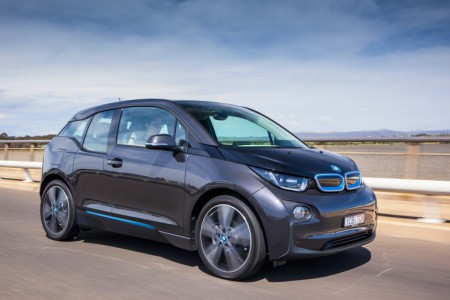After a long incubation period, the first cars released under BMW’s sustainability-focused “i” sub-brand – the i3 city car and i8 sportscar – have been hitting roads around the globe throughout 2014. We climbed aboard the i3 to find out how it performs.

BMW i3: It zips off the mark, turns on a dime, provides good visibility and it’s whisper quiet (Image: Gizmag)
We’ve previously looked at the make-up of the i3 in detail, but here’s a quick refresher. It’s a compact four seat, five door that’s a touch under 4 m (13 ft) long with short overhangs at both ends and an exceptionally tight turning circle of 9.8 m (32 ft – that’s 10 percent less than a Mini) and 2.5 turns lock to lock.
The BMW-developed electric motor is located at the back, providing 125 kW and 250 Nm (184 lb-ft ) of torque to the rear wheels through a single speed automatic transmission. In addition to the battery electric vehicle (BEV) model there’s a range extender version in which a 34-hp, 650 cc two-cylinder petrol engine from BMW Motorrad sits alongside the electric motor and acts as a generator (i.e. it charges the battery but, unlike hybrid cars, it doesn’t drive the wheels).
The modular 360 V, 21.8 kWh (18.8 kWh useable), 96 cell, liquid-cooled lithium-ion battery pack is spread across the underbody and can be charged in 11 hours using a domestic wall plug or six hours using BMW’s i Wallbox. BMW says DC fast charging can deliver 80 percent charge in just 30 minutes.
On a single charge the i3 has an “everyday range” of 160 km (100 mi). Using ECO mode can bump that closer to 200 km (124 mi), while the range extender version can travel around 300 km (186 mi). Acceleration is put at 0-100 km/h (0-62 mph) in 7.2 seconds and importantly it still has plenty of zip for overtaking at higher speeds, with a 80-120 km/h (50-75 mph) time of 4.9 seconds, putting it on par with a BMW 435i. Top speed is electronically limited to 150 km/h (93 mph).
The i-series cars are based on an architecture that’s been created “from the ground up” for electric vehicles. The passenger cell is the first mass-produced using carbon fiber-reinforced plastic (CFRP) and the chassis is made of aluminum and other lightweight materials. This adds up to a car that weighs just 1,195 kg (2,634 lb) – the range extender adds around 120 kg (265 lb) to that figure.
Read more: Giz Mag
